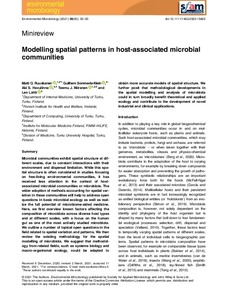Modelling spatial patterns in host-associated microbial communities
Havulinna Aki S; Niiranen Teemu J; Lahti Leo; Sommeria-Klein Guilhem; Ruuskanen Matti O
Modelling spatial patterns in host-associated microbial communities
Havulinna Aki S
Niiranen Teemu J
Lahti Leo
Sommeria-Klein Guilhem
Ruuskanen Matti O
WILEY
Julkaisun pysyvä osoite on:
https://urn.fi/URN:NBN:fi-fe2021050328503
https://urn.fi/URN:NBN:fi-fe2021050328503
Tiivistelmä
Microbial communities exhibit spatial structure at different scales, due to constant interactions with their environment and dispersal limitation. While this spatial structure is often considered in studies focusing on free-living environmental communities, it has received less attention in the context of host-associated microbial communities or microbiota. The wider adoption of methods accounting for spatial variation in these communities will help to address open questions in basic microbial ecology as well as realize the full potential of microbiome-aided medicine. Here, we first overview known factors affecting the composition of microbiota across diverse host types and at different scales, with a focus on the human gut as one of the most actively studied microbiota. We outline a number of topical open questions in the field related to spatial variation and patterns. We then review the existing methodology for the spatial modelling of microbiota. We suggest that methodology from related fields, such as systems biology and macro-organismal ecology, could be adapted to obtain more accurate models of spatial structure. We further posit that methodological developments in the spatial modelling and analysis of microbiota could in turn broadly benefit theoretical and applied ecology and contribute to the development of novel industrial and clinical applications.
Kokoelmat
- Rinnakkaistallenteet [19207]
